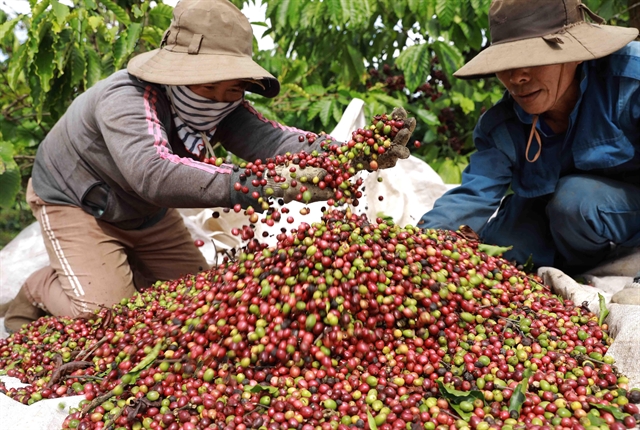 Economy
Economy

 |
| Farmers in Đắk Nông harvest coffee. Việt Nam’s coffee industry was facing uncertainty in maintaining export at high levels in the long run because the export remained heavily dependent of rising prices on supply shortage, not on the added value of coffee products. — VNA/VNS Photo Vũ Sinh |
HÀ NỘI — While Việt Nam's coffee industry was on track for another record export year, driven by rising prices due to supply shortages, experts said it's time for the industry to focus on quality to increase added value and export sustainably.
According to the Ministry of Agriculture and Rural Development, Việt Nam was expected to earn US$4.2 billion from exporting 1.7 million tonnes of coffee this year, a new high after setting the record at more than $4 billion last year, providing a firm foundation for the export target of $6 billion by 2030.
Phạm Quang Anh, director of the Mercantile Exchange of Vietnam’s Information Centre, said Vietnamese coffee exports could reach a record level this year thanks to domestic and global prices climbing to their highest levels in the past 15 years due to scarce supply, low coffee reserves, and a strong increase in global demand for Robusta.
Statistics from the General Department of Customs showed that Việt Nam’s coffee exports reached 1.266 million tonnes worth $3.16 billion from January to September, a drop of 7.3 per cent in volume but an increase of 1.9 per cent in value over the same period last year.
The average export price was $2,499 per tonne during this period, 9.9 per cent higher than the same period last year.
The average price in September was $3,151 per tonne, 3.2 per cent higher than August and 29.6 per cent higher than one year ago.
Despite strong exports, Việt Nam's coffee industry faces uncertainty in maintaining exports at high levels in the long run because the exports remain heavily dependent on rising prices due to supply shortages, not on the added value of coffee products.
This fact urged the coffee industry to shift its focus to improving product quality and aligning with market taste trends, especially in the major coffee consumption markets, which accounted for around half of global coffee imports, including the EU and the US.
Customs statistics showed that Việt Nam shipped 600,000 tonnes of coffee to the EU and the US in the first eight months of this year, representing 50 per cent of the country's total coffee export volume.
Major coffee import markets were transitioning from importing Robusta coffee beans to processed coffee.
According to the US Department of Agriculture, the US was becoming increasingly reliant on Arabica coffee and has progressively reduced Robusta imports from 6.1 million 60-kg bags in the 2010-11 crop year to 3.6 million bags in 2020-21. Processed coffee's share increased from 3.1 per cent in the 2018-19 crop year to an estimated 6.4 per cent in 2023-24.
According to the European Coffee Federation's statistics, the percentage of processed coffee surged from 2.3 per cent in 2017 to 5.5 per cent in 2021.
Việt Nam’s customs data also indicated a significant drop in Việt Nam’s Robusta coffee bean exports to the US, decreasing from 130,200 tonnes in 2018 to 90,500 tonnes in 2023, representing a decline of 27 per cent. Việt Nam predominantly exported raw beans to the US, a trend that remained largely unchanged from five years ago, indicating that Việt Nam has been slow to adapt to the evolving tastes of major markets.
Towards sustainability
Climate change was occurring globally, leading to extreme weather phenomena like El Nino and La Nina, which directly affected the coffee crop.
According to the Vietnam Coffee Cocoa Association, erratic rains and storms during the 2022 coffee harvest season in the Central Highlands caused the output to decrease by about 10-15 per cent. This year, El Nino also led to dryness in Việt Nam’s major growing areas. The association noted that the upcoming crop output might be 10-15 per cent lower, at around 1.47 million tonnes.
A Bloomberg survey estimated that coffee output might be 7 per cent lower than the previous harvest season.
While coffee prices remained high, Việt Nam was currently short of coffee for export. The Import-Export Department under the Ministry of Industry and Trade (MoIT) mentioned that the nation’s exports in the third quarter were slowing down due to limited supply.
The coffee supply was anticipated to increase in November when the 2023-24 harvest season began.
Quang Anh emphasised the importance for the coffee industry to concentrate on quality and enhance the added value of coffee products through processing to boost exports.
Enterprises and farmers should collaborate to establish production chains, making it more feasible to adopt modern technology and promote the shift from raw to processed coffee, he suggested.
Increasing processed coffee could be a solution for Việt Nam to boost exports, benefiting from signed free trade agreements that offer preferential tariffs of 0-5 per cent for processed coffee products, Trần Thanh Hải, deputy director of the Import-Export Department (MoIT), stated.
Hải stressed that the coffee industry couldn't separate itself from the global commodity market, which was being influenced by rising inflation, geopolitical impacts, increasing input costs, and heightened competition from major producers like Brazil and Indonesia.
All these factors would influence coffee prices, Hải said, urging companies to closely monitor the market for suitable business and production strategies.
He encouraged businesses to intensify trade promotions to broaden markets while concentrating on quality raising and processing to meet the demands of importing markets and to establish brands for sustainable exports. — VNS




